The goal is pretty straightforward: adjust the car’s handling to match your driving style. Every car behaves differently on the road. Some tend to understeer, while others lean towards oversteer. Ale na razie, let’s not dive into the details of engine layout or drivetrain.
Więc, the main objective is clear. What’s the challenge here? Balancing Handling and Stability. These two aspects go hand in hand. When you enhance handling, you often sacrifice stability. The car becomes more responsive, sticks to the road better, but at the cost of a higher chance of sudden grip loss. Up to a point, you can improve both handling and stability simultaneously. Jednakże, there’s a limit where pushing handling further can lead to a significant loss of stability. Na przykład, if you increase the speed at which the car changes direction, you also increase the risk of experiencing “snap oversteer,” między innymi.
The ideal goal is to find that sweet spot where the car handles at its best without trying to introduce you to the nearest barrier. But how do you achieve this?
Here’s the fundamental rule of tuning: The part of the car that loses traction first is the part that’s been made stiffer. In simpler terms, if the front suspension is stiffer than the rear, you’ll likely experience understeer. Z drugiej strony, if the rear suspension is stiffer than the front, you’ll tend to encounter oversteer.
Using this rule of tuning, you can adjust the stiffness of the front or rear suspension to either introduce or mitigate understeer or oversteer. Sounds straightforward, doesn’t it?
Opony
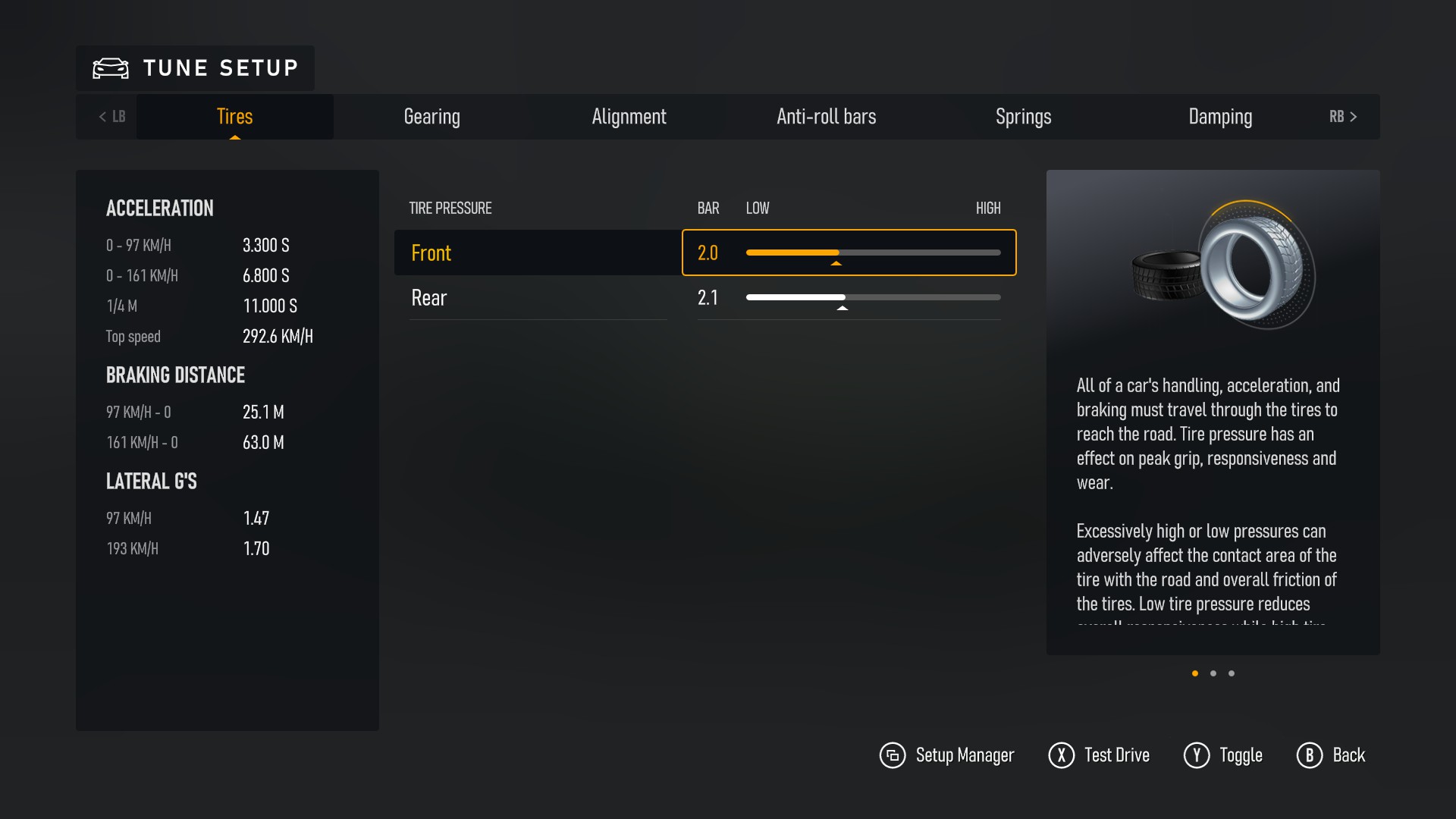
- If you raise the tire pressure, your steering will become more responsive, but you’ll sacrifice some grip. This means the car will turn sharply but lose traction faster.
- Z drugiej strony, if you lower the tire pressure, you’ll gain more grip, but it may come at the expense of some sharpness in your steering.
Jednakże, keep in mind that tire pressure tends to increase by about 0.2-0.5 bar (2-7 psi) as the tires heat up during driving. To set the right pressure, start by taking a few laps, and then use telemetry to check the tire pressure. If it’s higher than desired, decrease the pressure. If it’s lower, increase it.
Moim zdaniem, the ideal pressure is 2.2 bar (29 Psi).
Mechanizm napędowy

I’ll discuss gears in more detail later, but it’s quite straightforward. Either the car has a high top speed but requires a while to reach it, or the car boasts rapid acceleration but a lower maximum speed.
Сamber, Toe, Caster
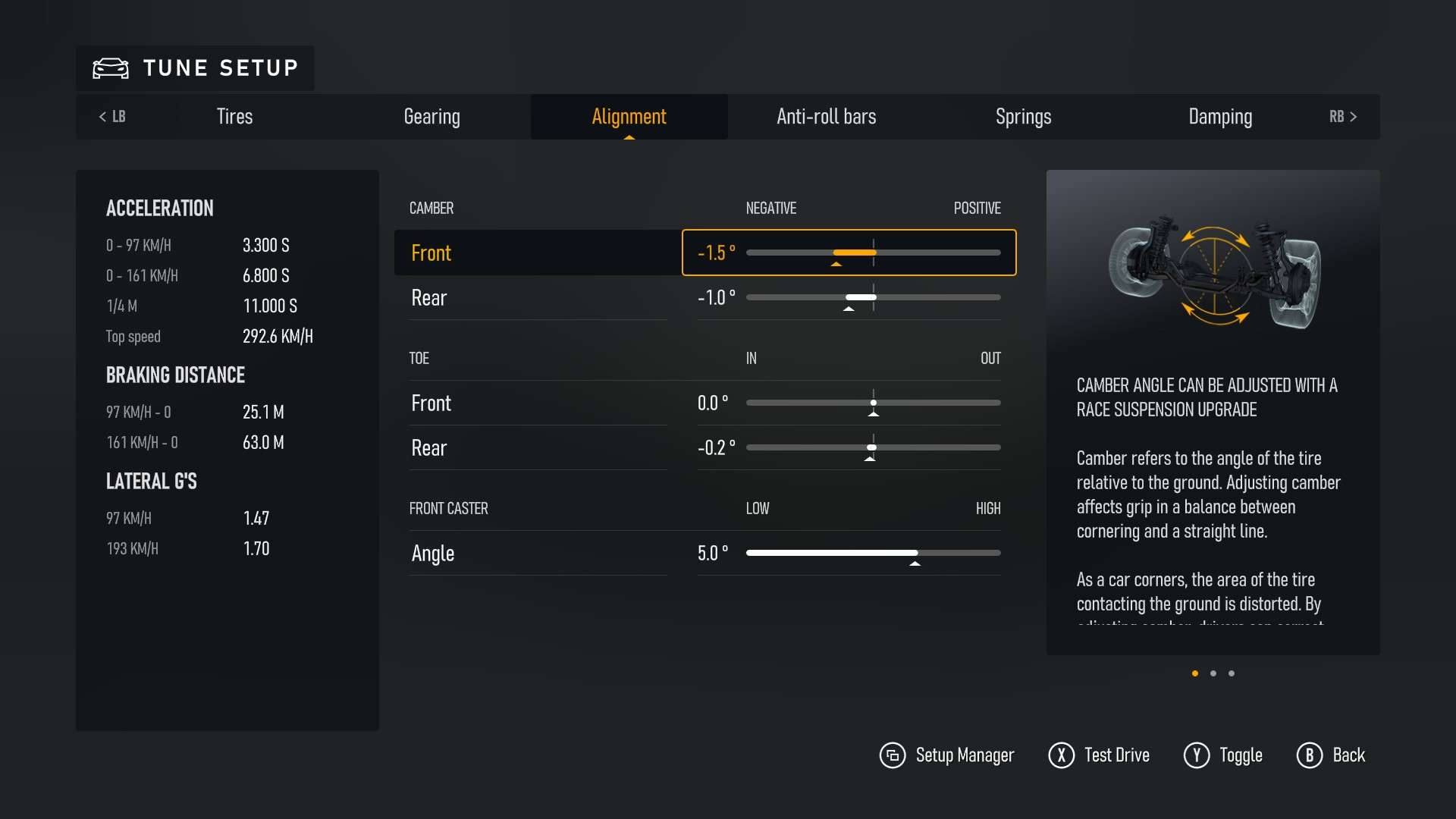
Wygięcie
- Front wheel camber – When you increase the camber, the car grips the road better in corners and turns more easily. Jednakże, it comes at a cost. You lose some braking power and stability when braking, and acceleration suffers in front-wheel-drive cars.
- Rear wheel camber – Similar to the front wheels, increasing the camber helps the rear wheels maintain better grip during cornering. Jednakże, this trade-off affects acceleration (in rear-wheel-drive cars), braking, and stability under braking.
Camber is adjusted using telemetry. When you’re in a corner, the inside of the tire should be 5-10 degrees hotter than the outside. If the outside is hotter than the inside, you should increase the camber. If the inside is too hot (15+ degrees difference), you should decrease the camber.
Toe
Toe-in or toe-out adjustments are generally not recommended because they can significantly affect steering. Jednakże, it’s done this way:
- Increasing TOE-OUT primarily affects how quickly the car responds at corner entry, making it turn more promptly when you start steering. Jednakże, this can come at the expense of straight-line speed and stability.
- Increasing TOE-IN should enhance stability during braking and slow down the initial steering response. The trade-off is that TOE-IN generates more tire scrub, which reduces straight-line speed. The more you deviate the tires from pointing straight, the more it negatively affects straight-line speeds.
This applies to both front and rear wheels. Czekać, NIE, it’s the opposite for the rear wheels:
Increasing Toe-In on rear wheels can enhance the car’s handling but reduce stability.
Increasing Toe-Out, z drugiej strony, increases stability during acceleration (making the car’s rear end less wobbly) but decreases handling.
Caster
- Increasing caster enhances the car’s stability at high speeds, making it more inclined to maintain a straight path. Jednakże, this improvement comes at the cost of reduced steering responsiveness when turning. Dodatkowo, bumps and curbs can “steer” the car and straighten it out.
- Z drugiej strony, reducing caster increases the speed of turning and makes the steering more responsive. Jednakże, the car loses stability at high speeds and becomes overly sensitive to steering wheel inputs.
Anti Roll Bars (ARB)

The Anti-Roll Bar (ARB) is an incredibly powerful tool for fine-tuning understeer and oversteer in a vehicle. The tuning process follows a fundamental rule:
- If the front ARB (Anti-Roll Bar) is stiffer than the rear, you’ll experience understeer.
- If the rear ARB is stiffer than the front ARB, you’ll encounter oversteer.
By increasing the stiffness of the front ARB, you enhance understeer. Odwrotnie, by reducing the stiffness of the front ARB, you increase oversteer.
Podobnie, by increasing the stiffness of the rear ARB, you amplify oversteer. Z drugiej strony, if you decrease the stiffness of the rear ARB, you increase understeer.
It’s important to note that ARBs primarily come into play when the car is turning, especially during the initial and middle phases of a turn.
Springs
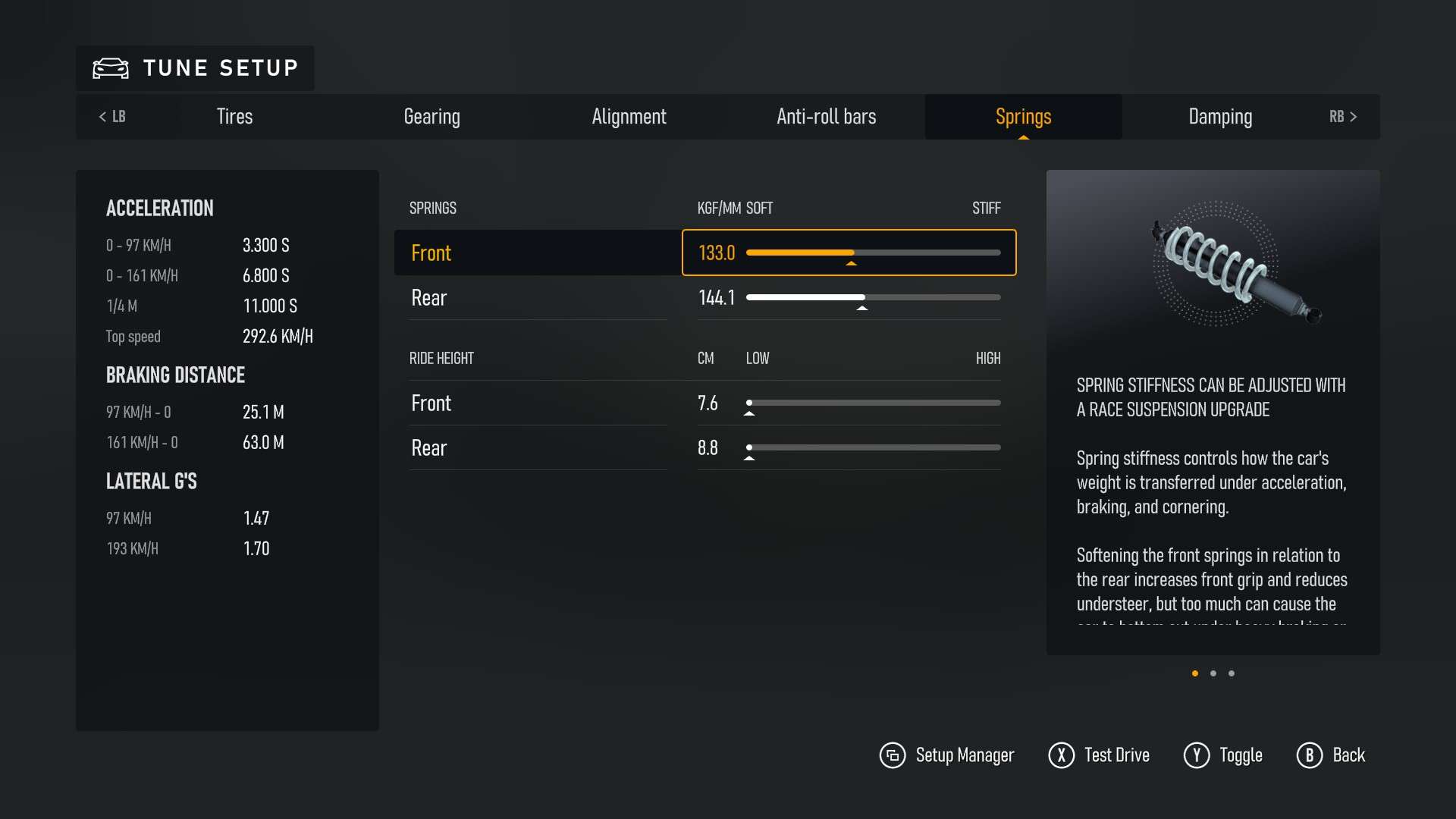
Before adjusting the spring stiffness, it’s crucial to set the ride height first.
Ride Height
Idealnie, for the car to be as close to the road as possible, you’d want the lowest ground clearance. Jednakże, on the track, there are bumps and potholes that can impact the suspension and potentially send you off course. If you enjoy driving on curbs, you might want to opt for a slightly higher ride height.
Lowering the ride height makes the car more responsive to steering inputs and easier to turn. But it also increases the risk of the suspension compressing to its limit, which can lead to a loss of control.
Odwrotnie, raising the ride height allows the car to handle track imperfections better without sacrificing stability. Jednakże, it does make the car less responsive.
Spring stiffness is adjusted based on the fundamental tuning rule and the weight distribution of the car. The rule is clear, but what exactly is weight distribution?
It’s quite simple. Each car has its unique weight distribution, indicating how much weight rests on the front and rear wheels. Na przykład, if the car weighs 1000 kg with a 50/50 weight distribution, it means 500 kg on the front wheels and 500 kg on the rear wheels.
If the weight distribution is 55/45, that means 550 kg on the front and 450 kg on the rear. The more weight on a particular part of the car, the stiffer the springs should be for that part.
If the front of the car is heavier, the front springs should be stiffer compared to the rear springs. And when you have a lower ride height, you need stiffer springs to prevent the suspension from compressing too much and potentially causing issues. I hope that clarifies things.
Podsumowując:
- Stiffening (+) the front springs tends to increase understeer.
- Softening (-) the front springs tends to increase oversteer.
- Stiffening (+) the rear springs tends to increase oversteer.
- Softening (-) the rear springs tends to increase understeer.
Dampers
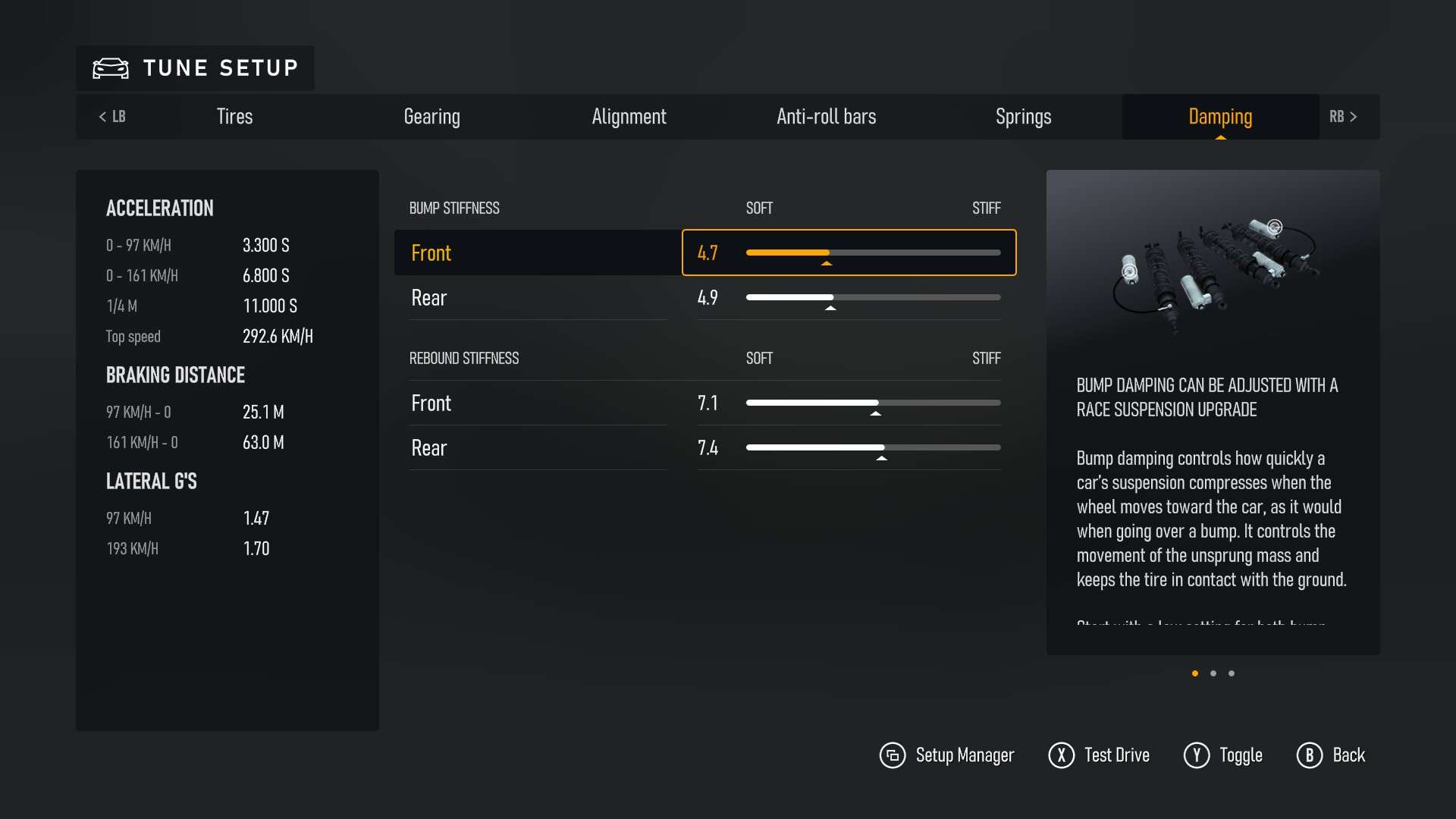
Dampers play a vital role in controlling how quickly loads transfer through the car rather than limiting the total amount of load transfer. Więc, they influence the car’s behavior during critical moments of transition, such as when you initially apply the brakes, release them, start turning into a corner, or apply the throttle. Making changes to the damper settings can impact these transition moments and how the car behaves during them.
Compression
Compression (Przód)
- Stiffer Compression: Slowing down the frontward weight transfer when you first apply the brakes. The trade-off is a slight reduction in compliance.
- Softer Compression: Increasing grip on the front tires due to improved compliance but potentially compromising the vehicle’s stability.
Compression (Rear)
- Stiffer Compression: Most effective in reducing understeer when turning into a corner and during mid-corner moments. It also resists understeer when you first apply the throttle, although it can lead to oversteer when turning into the corner and applying throttle at the exit.
- Softer Compression: Enhancing rear grip through improved compliance. This adjustment shifts the handling balance towards understeer during corner entry and provides better power-down. Jednakże, it may increase understeer during turn-in and under throttle-on conditions, such as when exiting a corner.
Rebound
Rebound (Przód)
- Stiffer Rebound: When you release the brakes during corner entry, it leads to a more positive initial turn-in and less understeer. Jednakże, if taken to the extreme, it can result in oversteer during turn-in.
- Softer Rebound: Releasing the brakes at corner entry results in better tire compliance, but it shifts the handling balance towards understeer. The trade-off is the possibility of increased understeer when exiting the corner.
Rebound (Rear)
- Stiffer Rebound: Increases understeer at corner entry. The potential drawback is reduced compliance when you open the throttle.
- Softer Rebound: Most noticeable at corner entry, it reduces understeer and improves compliance when you open the throttle. Jednakże, the downside is that it might make the car less controllable during corner entry.
Suspension Geomentry
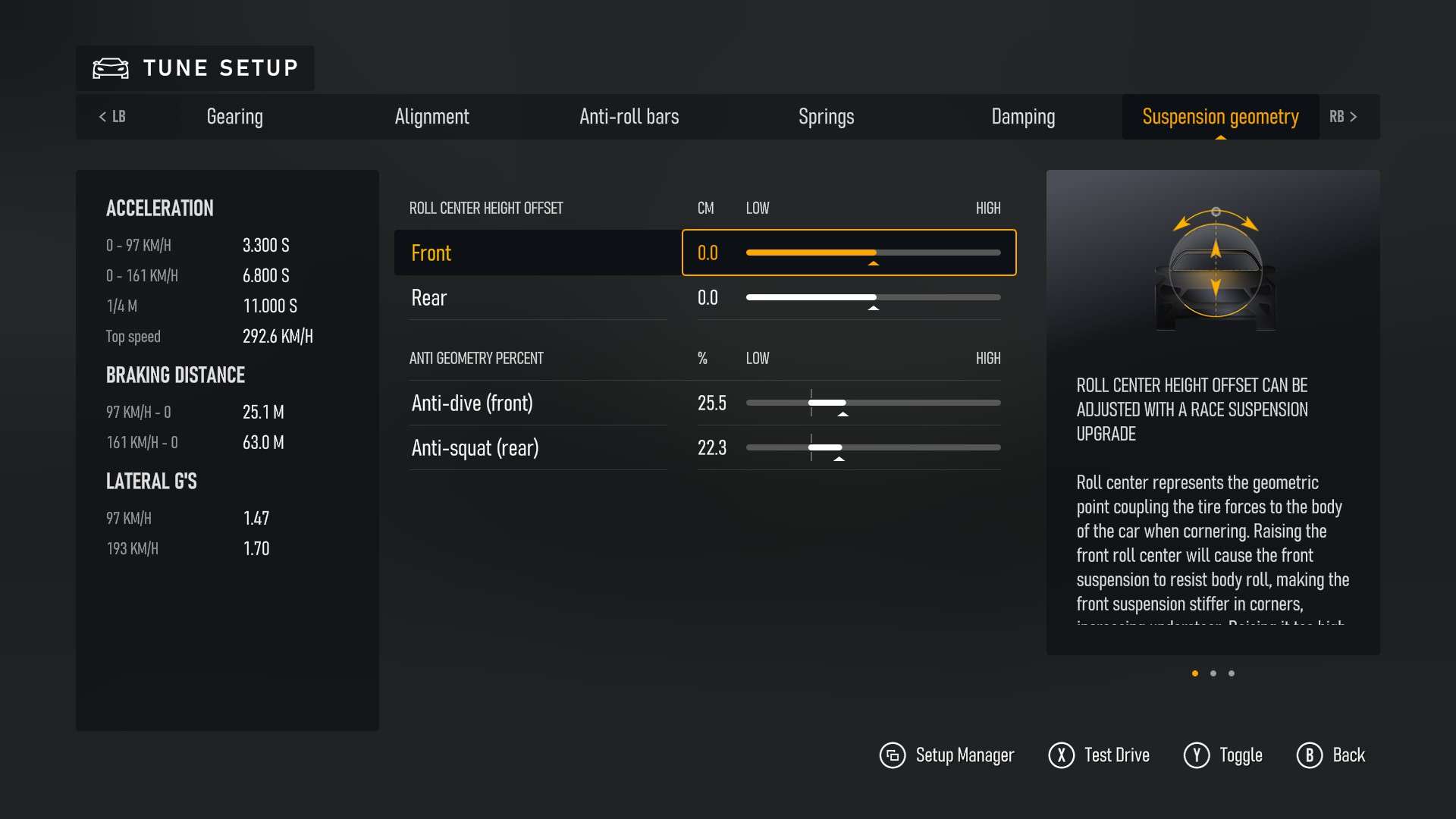
Aero
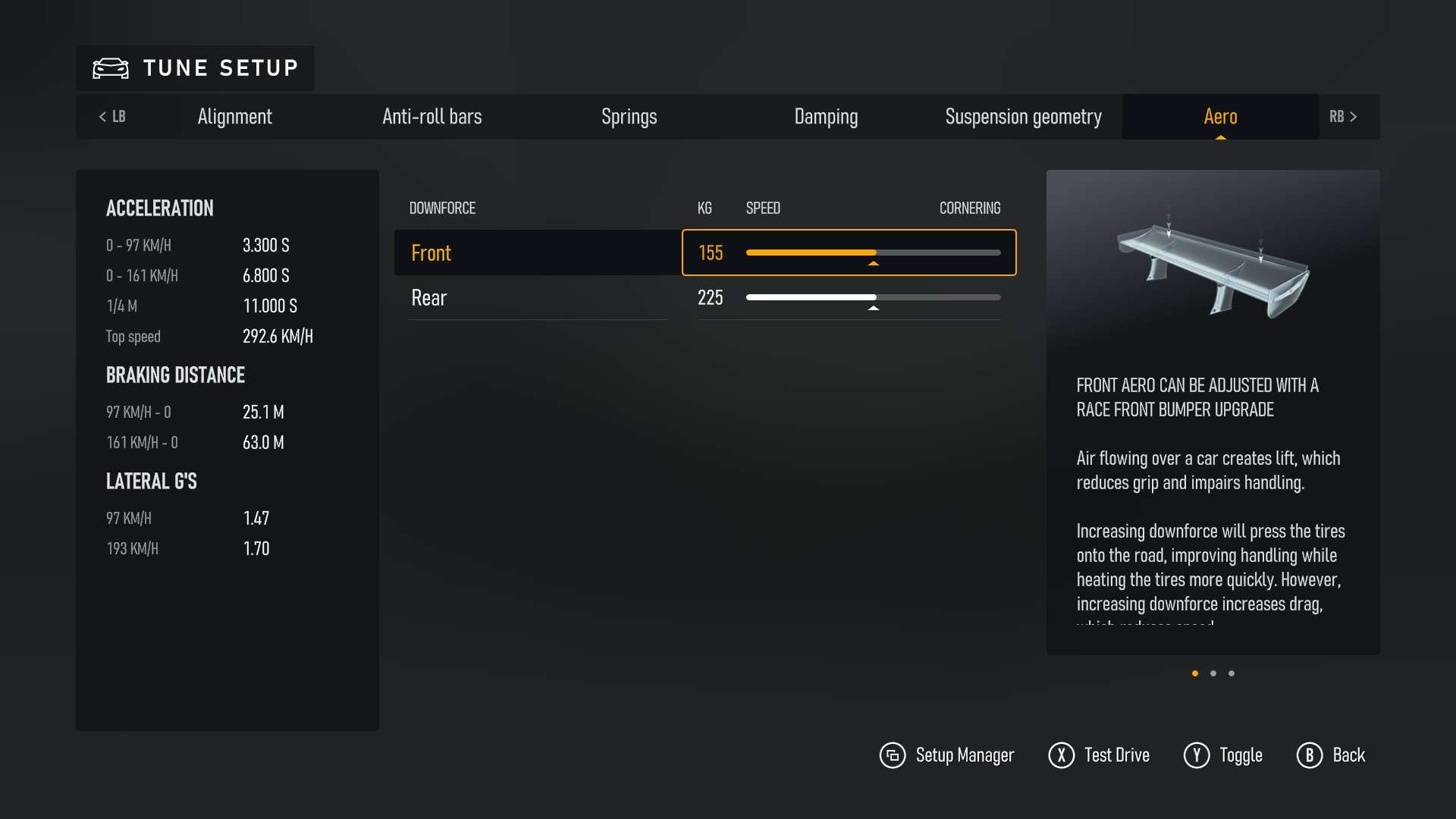
Aerodynamics is pretty straightforward to grasp. When you boost downforce, you enhance grip. Jednakże, w zamian, you sacrifice both acceleration and top speed. Keep in mind that aerodynamics only come into play at higher speeds; they don’t have much effect in slow corners.
But a word of caution: you can go too far with aerodynamics:
- If there’s excessive aero in the front, the car will tend to oversteer.
- Odwrotnie, if there’s too much aero at the rear, the car is more likely to experience understeer.
Hamulce

Hamulce? Who needs brakes? They only slow the car down.
But in reality, brakes are essential, and here’s why: When a car slows down, weight shifts towards the front tires, improving their grip while decreasing grip at the rear. The key is to adjust the distribution of braking forces between the front and rear (known as brake bias) to maximize overall braking efficiency. If you continue applying the brakes while turning into a corner, the brake bias setting will also impact the car’s balance during turn-in.
Brake Bias
- Increasing Front Bias: Indicated by a higher number, increasing front brake bias directs more braking force to the front tires. This stabilizes the car during braking and increases understeer when entering a corner. Jednakże, too much front bias underutilizes the rear tires, reducing overall braking efficiency.
- Reducing Front Bias: This allocates more braking power to the rear tires, Który, within limits, enhances braking efficiency. Jednakże, excessive rear brake bias has two downsides: it decreases overall braking efficiency and, more critically, if the driver doesn’t brake in a straight line or doesn’t downshift smoothly, it can cause the rear tires to lock up, leading to a loss of vehicle control. With a moderate amount of rear brake bias, the car may tend to oversteer at corner entry when the brakes are released.
Brake Pressure
Mówiąc najprościej, higher numbers mean you need less pressure on the brake pedal to achieve stronger braking. Lower numbers mean you have to apply more pressure. This setting can be useful if you find yourself consistently under- or over-braking. Adjust the pressure values accordingly.
Na przykład, if you often find yourself under-braking and your muscle memory only allows you to press the brakes up to 50%, but you know you should be applying up to 85%, you can gradually increase the pressure until you reach that value without locking up the wheels.
Differential

In a corner, the inside and outside wheels rotate at different speeds, and the differential determines this difference. The acceleration setting comes into play when you’re accelerating, while the deceleration value applies when you’re braking or coasting.
The concept behind the differential setting is straightforward: Increasing the value speeds up the locking time and reduces the difference in wheel rotation.
Acceleration:
- Więcej %: Increases oversteer, reduces understeer, especially when exiting tight corners. It also reduces tire spin when there’s insufficient traction.
- Mniej %: Increases understeer, reduces oversteer, especially when exiting tight corners. It also increases tire spin when there’s insufficient traction.
Deceleration (Braking and Coasting):
- Więcej %: Enhances braking stability and effectiveness. It reduces the car’s willingness to turn, promoting understeer.
- Mniej %: Reduces braking stability and effectiveness. It increases the car’s willingness to turn and decreases understeer.
Notatka: More detailed descriptions are being worked on for various drive types – RWD, FWD, AWD.
Kierownica
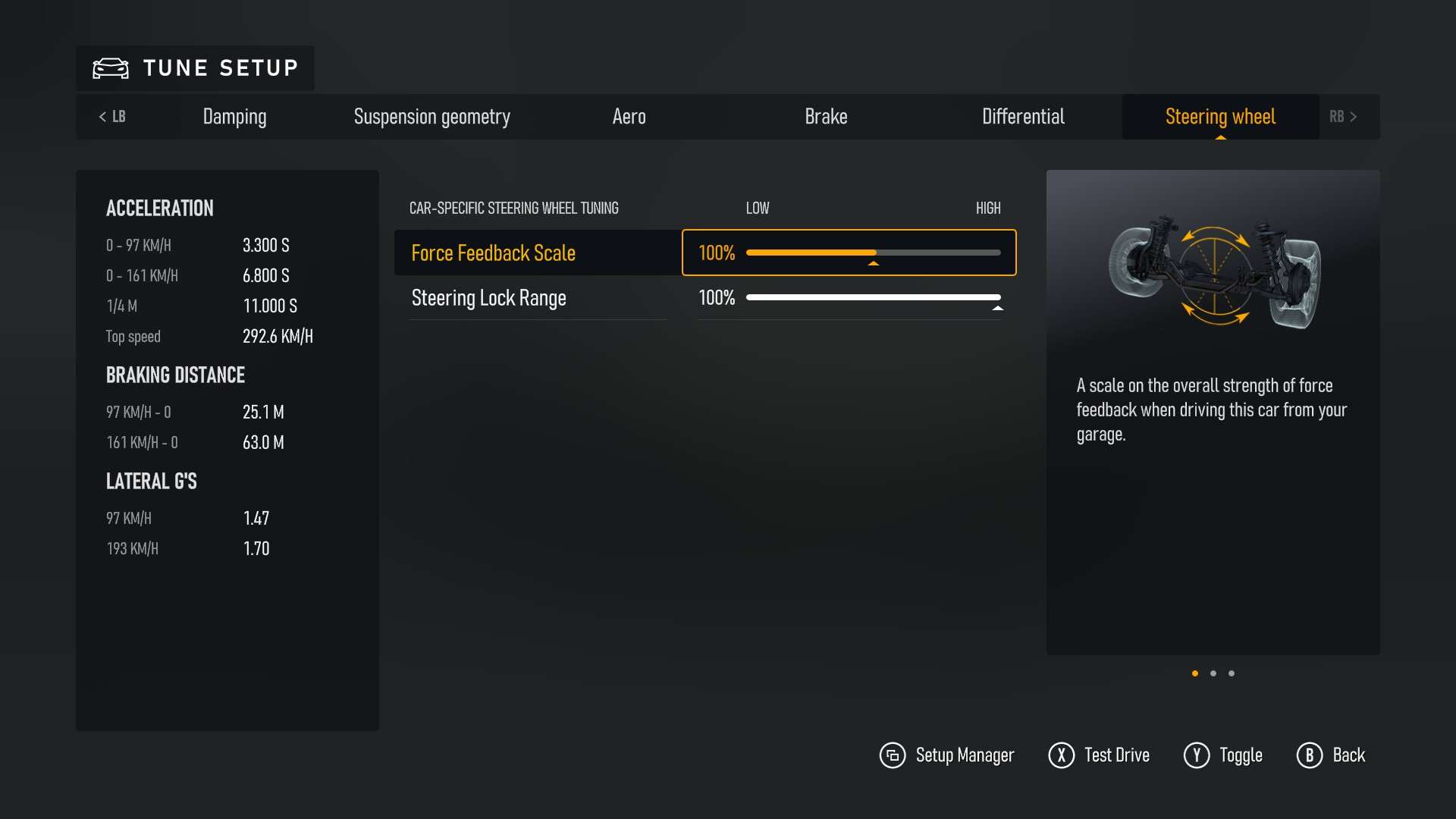
To wszystko, co dzisiaj udostępniamy w tym celu Forza Motorsport przewodnik. Ten przewodnik został pierwotnie stworzony i napisany przez Boris ☭. Na wypadek, gdybyśmy nie zaktualizowali tego przewodnika, możesz znaleźć najnowszą aktualizację, postępując zgodnie z tym połączyć.